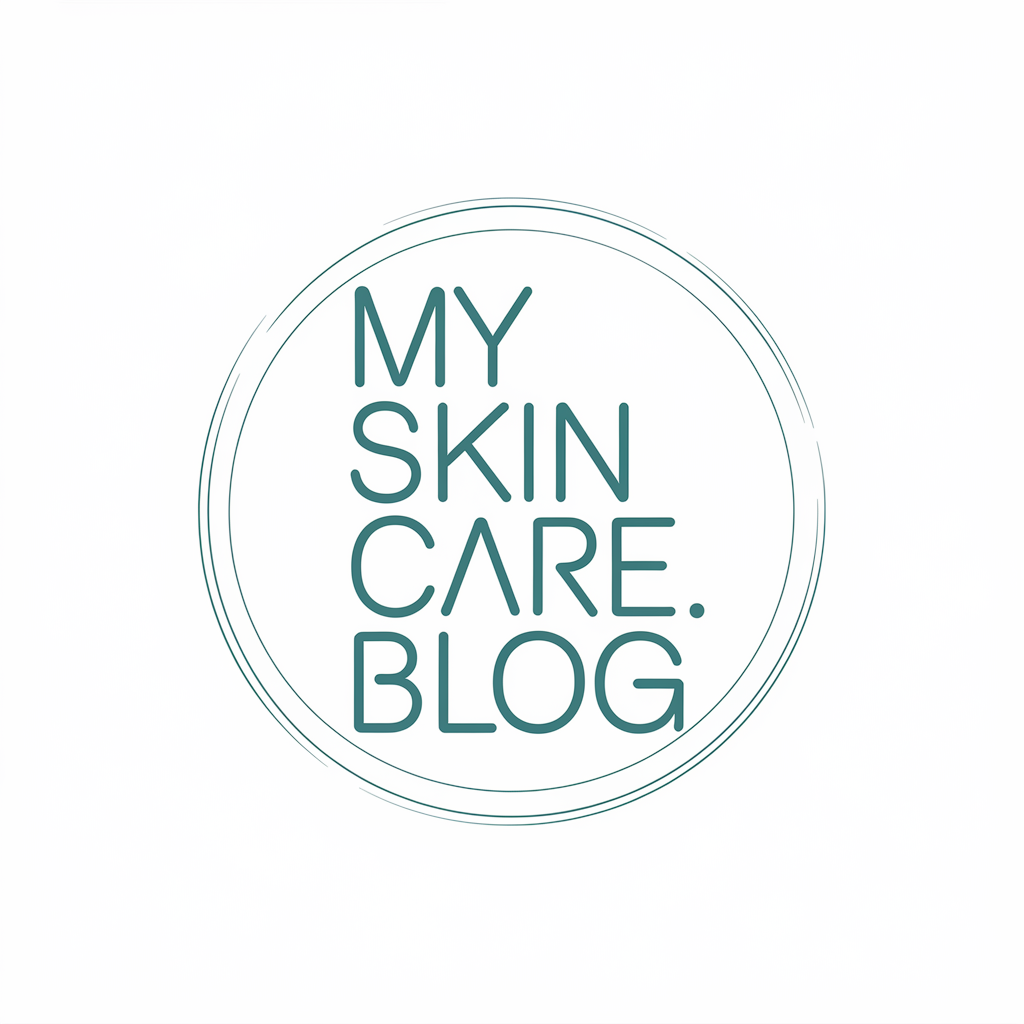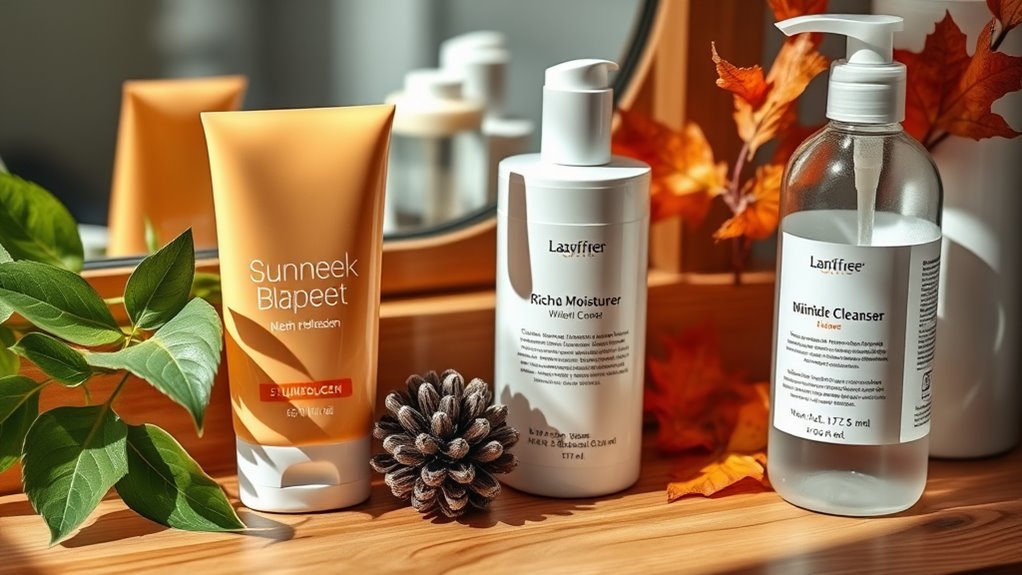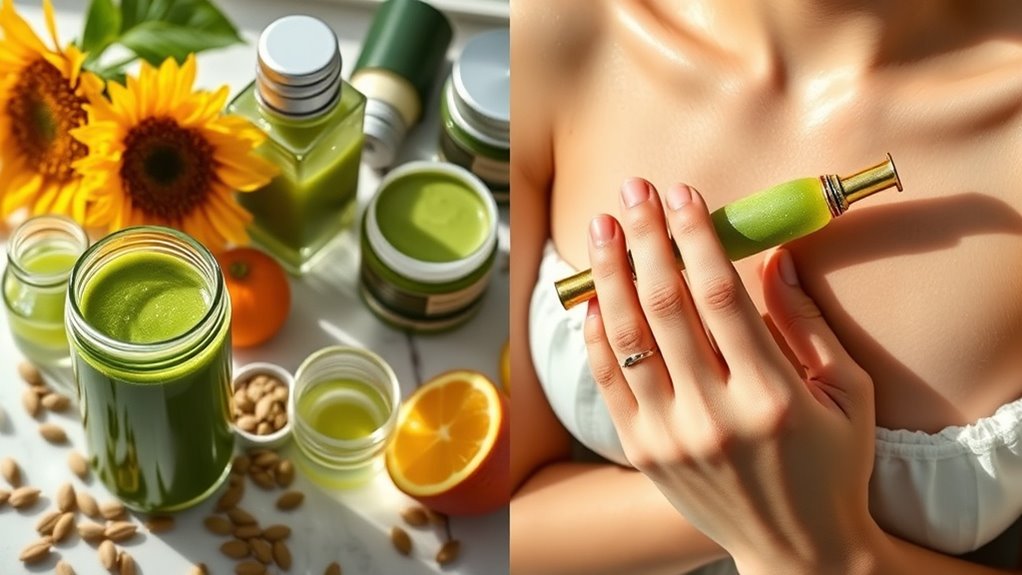The Seasonal Skin Switch- What to Change and When
You’ll safeguard your skin in winter by using thick, ceramide-rich moisturizers and humidifiers to combat dryness. In spring, switch to lighter, non-comedogenic formulas with antioxidants for pollen and UV protection. Summer demands broad-spectrum SPF 50+ applied frequently, plus reduced exfoliation to handle intense sun. For fall, incorporate hyaluronic acid to lock in moisture against drier air. These adjustments keep your skin resilient, paving the way for deeper strategies ahead.
Key Takeaways
- In winter, prioritize thick, emollient moisturizers and gentle exfoliants for hydration.
- In spring, switch to lighter moisturizers and antioxidant serums with daily SPF 30+.
- In summer, apply broad-spectrum SPF 50+ sunscreen every two hours and reduce exfoliation.
- In fall, increase occlusive creams and hyaluronic acid to maintain moisture barriers.
- Year-round, use pH-balanced cleansers and consistent SPF to protect against environmental damage.
Winter Skincare Essentials
As winter sets in, you’ll notice your skin losing moisture faster due to cold air and low humidity, so prioritize hydration to prevent dryness and irritation. It’s essential to identify signs of dehydrated skin to ensure you’re addressing the right issues before they worsen.
In your seasonal routine, select a thick, emollient moisturizer with ceramides or hyaluronic acid to seal in moisture; apply it twice daily. Use a gentle, non-stripping cleanser to avoid stripping natural oils.
Incorporate a humidifier to combat indoor dryness, and opt for protective layers like scarves to shield against wind.
Regularly check for irritation and adjust your routine based on skin feedback for optimal winter resilience.
Additionally, explore product recommendations that include ingredients like shea butter for extra nourishment to combat the effects of dry, cold weather.
Spring Transition Tips
With spring’s arrival, you’ll need to adjust your skincare routine to tackle emerging challenges like increased pollen, fluctuating humidity, and stronger UV rays.
Opt for lighter, non-comedogenic moisturizers to balance hydration amid changing weather. Incorporate antioxidant serums, such as those with vitamin C, to neutralize free radicals from pollen and reduce inflammation.
Apply a broad-spectrum SPF 30 daily to protect against intensifying sunlight without advancing to summer tactics. Gently exfoliate twice weekly with AHAs to slough off dead skin and enhance absorption.
Monitor for sensitivities and tweak formulations for optimal skin health. Stay hydrated by drinking water to support your barrier, ensuring resilience through the season. Additionally, include nutrient-rich foods in your diet to promote collagen production and maintain skin elasticity.
To achieve lasting hydration, incorporate lifestyle changes like maintaining a balanced diet rich in fruits and vegetables for enhanced skin barrier support.
Summer Protection Strategies
As summer arrives, you apply broad-spectrum sunscreen daily to shield your skin from UV rays and prevent damage. Additionally, steer clear of over-exfoliation to maintain skin health.
You maintain hydration by incorporating simple, effective tips like drinking water and using moisturizers suited for warm weather.
You enhance protection further with strategic use of shade and lightweight, UV-blocking clothing.
Moreover, consistent sunscreen application is vital because it serves as the most essential anti-aging measure by preventing premature aging.
Sunscreen Application
Applying sunscreen correctly protects your skin from harmful UV rays and reduces summer sunburn risk. You should select a broad-spectrum sunscreen with at least SPF 30 to block both UVA and UVB rays effectively.
Apply a generous amount—one ounce for your body and a teaspoon for your face—ensuring even coverage on all exposed areas, including ears and neck. Let it set for 15 minutes before sun exposure.
Reapply every two hours, or immediately after swimming, sweating, or towel-drying. Choose water-resistant formulas for outdoor activities, and always check the expiration date to maintain its protective efficacy.
Don’t skip cloudy days; UV rays penetrate regardless. For best results, integrate this into your daily routine alongside hats and sunglasses.
Skin Hydration Tips
Maintaining hydrated skin during summer protects it from dryness and environmental stressors, so you must prioritize strategies that balance internal and external moisture.
Drink ample water—aim for eight glasses daily—to keep your body hydrated from within, supporting skin’s natural barrier.
Opt for lightweight, non-comedogenic moisturizers with ingredients like glycerin or aloe vera, applying them twice daily after cleansing.
Limit hot showers to lukewarm to prevent stripping oils, and use a humidifier indoors if air conditioning dries the air.
Regularly check your skin’s moisture levels and adjust routines to maintain optimal hydration effectively.
Shade and Clothing
Protecting your skin from summer’s intense UV rays requires strategic use of shade and clothing, which form essential barriers against sunburn and long-term damage.
You’ll minimize exposure by integrating these into your routine, drawing on scientific principles to prevent cellular harm and aging.
-
Seek natural or artificial shade during peak UV hours (10 a.m.–4 p.m.), as it blocks up to 75% of rays, fostering habits that preserve skin’s DNA integrity.
-
Choose UPF-rated clothing* like long-sleeve shirts and pants, which actively filter UVB and UVA, ensuring practical, everyday protection against *melanoma risks.
-
Layer with accessories such as wide-brimmed hats and UV-blocking sunglasses, empowering you to maintain barrier function and promote long-term epidermal health.
Fall Hydration Adjustments
As fall arrives and humidity levels drop, you’ll need to tweak your hydration routine to combat drier air and maintain your skin’s moisture barrier.
Cooler temperatures strip essential lipids, increasing transepidermal water loss and leaving skin more vulnerable. To address this, increase emollient use in your regimen, focusing on occlusive layers that lock in moisture.
Apply products right after washing to boost absorption, and prioritize internal hydration by upping water intake. Use humidifiers to elevate indoor moisture levels, and routinely evaluate your skin’s texture for early dryness signs, adjusting frequency as needed for sustained barrier health. For enhanced hydration during this season, consider incorporating hyaluronic acid into your routine to help retain moisture and improve skin elasticity.
To maximize these efforts, incorporate layering techniques for all-day hydration by strategically combining and timing your product applications.
Key Products for Seasonal Shifts
Transitioning into new seasons, you’ll find that essential products like humectants, occlusives, and gentle exfoliants play a crucial role in adapting your routine; moreover, opting for gentle cleansers can help minimize potential negative impacts from ingredients that may irritate various skin types during these changes.
Humectants attract moisture to combat dryness, while occlusives lock it in, preventing seasonal damage. Select these based on your skin type for optimal results.
-
Humectants enhance hydration by drawing water from the environment, maintaining your skin’s barrier during humid or dry shifts.
-
Occlusives form a protective layer, shielding against wind and cold to preserve moisture and reduce irritation.
-
Gentle exfoliants support surface renewal, ensuring products penetrate effectively without disrupting your seasonal balance.
For instance, hyaluronic acid can be a highly effective humectant for drawing and retaining moisture in various skin types.
Exfoliation by Season
Exfoliation varies by season, requiring you to tailor your routine for optimal skin health.
In winter, cold air dries your skin, so use gentle chemical exfoliants like AHAs twice weekly to remove dead cells without stripping moisture. Over-exfoliation can lead to premature aging by damaging the skin’s protective barrier.
Summer’s heat increases oil and pollution, prompting you to exfoliate three times a week with enzymes to prevent clogged pores.
Spring’s pollen and winds demand lighter physical scrubs to reduce irritation.
In fall, as humidity drops, incorporate beta hydroxy acids to clear buildup and ease the shift to drier conditions.
Monitor your skin’s response for best results.
Additionally, to prevent skin damage, always be mindful of common exfoliation mistakes when adjusting your routine.
Moisturizer Changes for Weather
Just as weather shifts, you must adapt your moisturizer to protect your skin’s barrier and prevent issues like dryness or oiliness.
In humid conditions, switch to lightweight, water-based formulas to avoid clogging pores, while dry climates demand thicker, occlusive creams for enhanced hydration. This tailored approach maintains your skin’s pH balance and resilience.
-
Adjust for humidity: Use gel moisturizers in high-humidity seasons to lock in moisture without greasiness.
-
Match your skin type: Opt for oil-free options if you’re prone to acne in warmer, moist weather.
-
Incorporate key ingredients: Choose humectants like glycerin for arid periods to draw and retain water effectively.
Sun Care Variations
As you adapt your moisturizer for varying weather, tailor your sun protection to seasonal shifts for optimal skin defense. In summer, you boost SPF to combat stronger UV rays; in winter, you prioritize UVA-blocking formulas despite weaker sunlight. Always select water-resistant options for activities.
| Season | Recommended SPF | Key Tips |
|---|---|---|
| Summer | 50+ | Reapply every 2 hours |
| Spring | 30-50 | Layer under makeup |
| Fall | 30 | Focus on face and hands |
| Winter | 30 | Use with moisturizers |
| Year-Round | 30 minimum | Check for broad-spectrum |
You select sunscreen based on skin type—mineral for sensitive—ensuring year-round efficacy against damage.
Year-Round Routine Maintenance
Maintaining a consistent skin care routine year-round protects your skin from daily stressors and promotes long-term health. This foundation shields against environmental damage, regulates moisture levels, and supports barrier function, regardless of seasonal shifts.
To optimize your routine, focus on these essential practices:
-
Cleanse daily with a pH-balanced product to remove impurities while preserving your skin’s microbiome.
-
Moisturize consistently to maintain hydration and strengthen the epidermal barrier against pollutants.
-
Apply broad-spectrum SPF every day to prevent UV-induced aging and inflammation.





